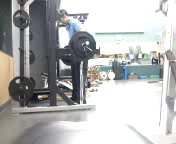The perfect squat: from the bottom up!
The squat is touted as one of the best strength training exercises, though it is most often performed with inconsistent depth, the knees shearing past the toes and/or a rounding back. Such vulnerable joint positions will result in setbacks that will blunt progression. Setbacks like irritation and injury.
Performing a squat from the bottom up, however, standardizes the depth, allows for a more optimal back and knee alignment as well as a better movement pattern. Rounding backs and knees shearing over the toes are more easily avoided when performing a squat from the bottom up.
In addition to improved alignment, performing a squat from the bottom up also discourages the hips from rising faster than the torso. The ways in which the bottom-up squat encourages better alignment and pattern, is by allowing one to preemptively assume sound squatting posture before exerting against the barbell.
Note: the steps below assume you have the barbell supports set at a reasonable depth conducive for sound spinal alignment. Such a depth will be dependent on factors like one’s proportions and flexibility. As such, warm up very gradually to determine if estimated height is correct.
1. Place the hips up against the bar so the ankles are right under the bar or as close to as balance allows. This ankle position under the bar encourages a safe position of the knees behind the toes.

2. Assume a stance width slightly wider than your shoulders. A sufficient stance width is helps ensure a stable pelvis through the range of motion.
3. Evenly grasp the bar and squat under it so your upper back, just below your neck-base, is in contact with the bar. This bar position keeps the neck safer while squatting.
|
|
4. Stand-up. The position you’re standing from will encourage durable posture and an optimal movement pattern that has the trunk rising at the same rate as the hips for a perfect squat.
|
|
5. Descend back to the barbell supports and you’ll likely still be in the same durable position from which you started.
As can be seen, squatting from the bottom up encourages a more sound performance of this great exercise. Execution is from a consistent depth. The low back and knees are in strong position. Such a strong position commands a proper movement pattern. Retain sight, however, of the fact that, even with the most durable form, sound progression should always be utilized.



